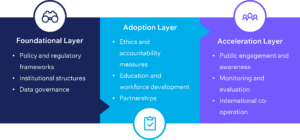14 October, 2024
Strategies to craft effective AI governance: Essential building blocks for nations


Artificial intelligence (AI) holds immense potential to revolutionise various sectors, from healthcare and education to transportation, finance, and the public sector. By harnessing the power of AI, nations can drive economic growth, enhance public services, and improve quality of life.
However, to fully reap these benefits, it is crucial to develop a comprehensive and robust AI governance framework. This framework should address the development, deployment, investments, and regulation of AI technologies to ensure their ethical, safe, and beneficial use across all segments of society.
To successfully navigate the complexities of AI governance, nations must undertake a concentrated and multi-faceted approach that spans several critical layers. Achieving this requires the concerted efforts and collaboration of key stakeholders, including government bodies, industry leaders, academia, and civil society. The approach is best understood through three interconnected layers: the foundational layer, the adoption layer, and the acceleration layer. Each layer is essential and builds upon the others, forming a comprehensive framework for effective AI governance that fosters innovation and growth while protecting citizens’ rights and promoting fairness and accountability.


Foundational Layer
The foundational layer serves as the bedrock, encompassing essential elements like policy frameworks, institutional structures, and data governance. This layer establishes the legal, regulatory, and organisational infrastructure necessary for AI to thrive responsibly.
- Policy and regulatory frameworks: Establishing and updating legal and regulatory frameworks is crucial for guiding AI development and ensuring it aligns with national priorities and ethical standards. Such frameworks should address issues such as data privacy, security, accountability, online safety, and transparency. Technical standards and protocols should be defined to ensure AI systems’ interoperability, safety, and reliability, aligning with international standards. Additionally, nations should also develop a comprehensive national AI strategy that is in line with their broader national development goals to propel responsible AI adoption and development. Such frameworks will serve as the backbone for AI governance, providing clear guidelines for the responsible use of AI technologies.
- Institutional structures: It is necessary to create and strengthen institutions dedicated to AI oversight and development. Such institutions can include regulatory bodies or agencies responsible for overseeing AI development and implementation, mechanisms to promote inter-agency coordination across various government bodies to ensure a cohesive approach, and advisory committees comprising experts from academia, industry, and civil society to provide guidance on AI-related policies and ethical considerations. Finally, AI safety institutes should be set up to lead evaluations and safety research at the national level in collaboration with partners across the world. These institutions will play a pivotal role in coordinating efforts, setting standards, and fostering innovation within a controlled and ethical environment.
- Data governance: Effective data governance is crucial for the ethical and efficient deployment of AI technologies. This includes ensuring data privacy, security, and the ethical use of data, which is critical for building trust and enabling AI systems to function effectively. Nations should enact appropriate data privacy laws that clearly define how personal data can be collected, stored, processed, and shared. At a minimum, these laws should include consent requirements, data minimisation, individual rights to data, and data breach notifications. Countries should establish comprehensive security protocols and standards to safeguard data that should include encryption, access controls, regular audits, and incident response plans. Concurrently, nations should develop frameworks that facilitate responsible data sharing across borders and organisations while protecting privacy and ensuring compliance with regulations. Data-sharing agreements should outline the terms, conditions, and responsibilities for data use and protection, anonymisation, and de-identification of personal data before sharing, international agreements, and standards to govern cross-border data flows, and alignment with ethical principles of fairness, transparency, and respect for individual rights. Finally, open data initiatives can drive innovation and transparency by making non-sensitive data publicly available.
Adoption Layer
The adoption layer builds upon the foundation by focusing on ethics, education, and partnerships. This layer ensures that AI technologies are adopted with a commitment to ethical practices, widespread education and awareness, and collaborative efforts between the public and private sectors.
- Ethics and accountability measures: To ensure AI technologies are developed and used in a manner that is ethical, transparent, and accountable, nations must implement robust mechanisms that build public trust and promote fairness. This involves establishing ethical guidelines that address issues such as bias, fairness, and the societal impact of AI, ensuring that the technology is used for the greater good. To promote transparency, AI developers should be encouraged to disclose how algorithms work, including the data sources, decision-making processes, and underlying logic that will help identify potential biases. Transparency also enables external audits and reviews, fostering an environment where AI development is open and accountable to oversight. Nations should require comprehensive impact assessments for AI projects, evaluating their social, economic, and environmental effects along with appropriate accountability mechanisms, including guidelines and protocols for AI development, deployment, and use.
- Education and workforce development: Implementing educational programmes to improve AI literacy among the general public, policymakers, and business leaders will be key to ensuring the necessary cultural shift to propel AI adoption across all levels. Nations should also develop training and reskilling programmes specifically targeted at building a skilled workforce capable of developing and managing AI technologies. Industry-academia partnerships should be promoted to advance AI research and integrate AI-related courses into educational curricula.
- Partnerships: Collaboration between the public and private sectors, as well as with international partners, is key to advancing AI adoption. Ample support should be provided to public-private partnerships to promote collaborative R&D initiatives to drive AI innovation and address societal challenges. Finally, promoting open data initiatives and policies will be crucial to enable access to high-quality datasets for AI research and development.
Acceleration Layer
The acceleration layer sits at the top, driving the rapid and impactful implementation of AI through public engagement, international cooperation, and ongoing monitoring and evaluation. It ensures that AI technologies are not only widely adopted but also continuously optimised and aligned with societal goals.
- Public engagement: Public engagement fosters transparency and trust, which are essential for the successful adoption of AI technologies. Governments should organise public consultations and open forums to gather diverse perspectives on AI governance. These forums should be inclusive, welcoming input from various stakeholders, including citizens, experts, industry representatives, and civil society organisations. Conducting awareness campaigns is also necessary to inform citizens about the benefits and risks of AI technologies. Additionally, governments should publish regular transparency reports on AI policies, initiatives, and regulatory actions detailing the progress of AI projects, the outcomes of public consultations, and any changes to AI regulations.
- International cooperation: Nations must work together to establish common standards, share knowledge, and address cross-border challenges, ensuring that AI development benefits all. Harmonising national AI regulations with international standards will facilitate cross-border collaboration and trade. This can help create a level playing field for businesses and ensure that AI systems are safe and reliable worldwide. It is equally important to collaborate with other countries to address cross-border challenges related to AI, such as cybersecurity and data privacy. Joint efforts can include sharing threat intelligence, developing common security protocols, and coordinating responses to cyber incidents. Engaging in knowledge-sharing initiatives with other nations will help to diffuse learnings from best practices and advancements in AI governance. Sharing expertise and resources to support capacity-building efforts in developing countries can promote global AI development that is inclusive and ethical.
- Monitoring and evaluation: Continuous monitoring and evaluation are critical for ensuring that AI governance frameworks remain effective, adaptable, and responsive to emerging challenges. Monitoring should be comprehensive, covering not only the technical and economic aspects of AI but also its social and environmental impacts. This broader perspective will help policymakers understand the full implications of AI on society, the economy, and the environment, enabling them to make more informed decisions. To this end, implementing real-time monitoring systems to track the deployment, performance, and broader impact of AI technologies will allow for the early identification of potential issues and ensure that AI systems operate as intended. Simultaneously, developing comprehensive frameworks for evaluating the effectiveness of AI policies and regulations with metrics and indicators that measure the success of AI initiatives will be necessary to identify areas for improvement. Implementing pilot programmes to test new AI policies and regulations before rolling them out on a larger scale will allow for experimentation and refinement, ensuring that policies are effective and practical.
These layers are not isolated; they are interdependent and dynamic, with constant feedback loops that allow for adaptation and improvement. Depending on the maturity of a nation’s AI ecosystem, governments can focus their efforts on different layers while ensuring that all layers are continuously reinforced. This structured approach will enable nations to develop a resilient and forward-looking AI governance framework capable of navigating the challenges and opportunities presented by AI.


Authors







